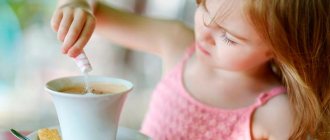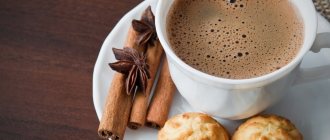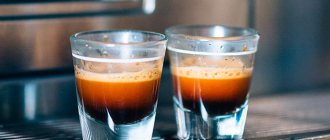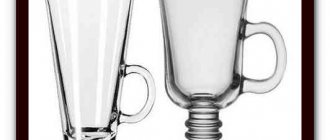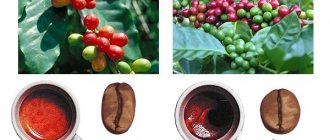Many adults remember being given a delicious coffee drink in kindergarten. This is one of the most pleasant memories of childhood. I have always been interested in knowing the composition of children's “coffee”. And one day I came across his recipe. Now I often delight my children with this drink. It consists of a small amount of available ingredients and is easy to prepare. Coffee drinks for children are absolutely safe as they do not contain caffeine. In this article I will share a classic recipe for children's “coffee”.
Why children should not drink natural coffee
The main component of coffee, caffeine, is a powerful stimulant. When consuming an extracted coffee drink from natural beans, it enters the body in significant quantities.
From coffee, a baby can become nervous, whiny, and easily excited by any minor event. The systematic intake of caffeine into a fragile body develops persistent sleep disturbances. Nervous excitement is extremely dangerous due to excessive consumption of energy, and therefore nutrients. Thus, coffee consumption at an early age leads to delayed physical development and disturbances in the normal mental state, including:
- Violation of salt metabolism. As a strong diuretic, caffeine promotes frequent urination, which in turn flushes a large amount of beneficial substances from the body.
- Heart rhythm failure. Caffeine can cause arrhythmia. This condition causes chest discomfort or pain.
- Increased secretion of gastric juice and the development of early gastritis.
What can replace coffee for children?
Against the background of such a picture, the answer to the question “what do they give children in kindergarten?” becomes obvious. Children receive a surrogate, or coffee substitute. The drink contains natural ingredients of plant origin - barley, chicory, acorns, soy. All ingredients go well together and taste great individually. In most cases, the products are fried and finely chopped before consumption.
In the store you can find ready-made powder surrogates. Their recipes were developed in distant socialist times and still remain unchanged. All components are absolutely safe, because completely natural. You can purchase the extract in retail chains (less often in a supermarket). The following names will appear on the packaging:
- "Morning". Barley-rye mixture with a small part of chicory;
- "Evening". Exclusively roasted barley grain;
- "Fragrance." Drink made from roasted barley and chicory;
- “Golden Ear”, “Summer”. Chicory and barley in equal parts.
It is better for children to replace coffee with chicory
Coffee is the best dessert in the world
Coffee is often used in the preparation of sweets and various confectionery masterpieces. Why don’t you try to turn such a seemingly familiar drink into a real sensation and, one might even say, a full-fledged dessert?
Making cheese coffee:
Brew two spoons of natural coffee in a cezve, heat 50 ml of cream, add a couple of teaspoons of cream cheese and a spoon of powdered sugar, pour the mixture with hot coffee and beat thoroughly with a blender. Add a little sugar and enjoy a new taste of your favorite drink with the whole family.
First of all, you need to understand well that a child’s body is fundamentally different from an adult’s. In the first hours after birth, the baby is practically sterile and helpless to the influence of any harmful factors. By receiving antibodies and various biologically active substances with milk, the child’s body adapts somewhat, its protection increases, but for a long time some specific features characteristic only of young children continue to play an important role in relationships with the outside world.
One of these features is the structure and incomplete development of the functions of the gastrointestinal tract. In infants, the digestive glands of the stomach are practically undeveloped, which is why gastric juice has almost neutral acidity and can only “cope” normally with mother’s milk. In the second year of life, the activity and acidity of gastric juice increase, making greater variety possible in both food and drinks.
It must be remembered that the intestinal mucosa of a child is more permeable than that of adults. That is why the child’s body, as they say, is open to the intake of various, and often harmful, substances. In general, in pediatrics the concept of “harmful substance” goes beyond the generally accepted ones. What in normal doses is neutral or provides some benefit to an adult may lead to undesirable consequences for a child. And even at first glance, a harmless and familiar drink can be fraught with many both surprising and unpleasant surprises.
Maybe some seagull?
Tea may have been the very first prepared beverage on earth: it has been praised for thousands of years by Chinese aristocrats, Indian yogis, Japanese samurai and Tibetan monks. Tea is so popular that few people can imagine their day without it. Moreover, in recent years, many publications have appeared about the benefits of black and, in particular, green tea. Such information reduces the vigilance of even the most discerning parents: is it possible to argue with modern science and centuries-old experience? Of course not. But not in the case of small children!
The whole variety of teas is represented by black, red, white, yellow and green varieties. The color of tea does not depend on the type of tea tree, but on the processing method. Black tea goes through the full tea production cycle and is subjected to enzymatic treatment. Green tea only undergoes a small part of the processing process and is otherwise called non-enzymatic. The remaining teas are only intermediate links in the processing of green tea into black. The substances contained in tea are amazing in their diversity. There are not so many truly harmful substances in tea, but, as mentioned above, in the case of children, any potential danger should be considered as real. The main component of tea is caffeine. Of course, tea contains trace amounts of it, but its effect is insignificant only for adults. In children, caffeine from strongly brewed tea (as well as from weakly brewed tea, but consumed in large quantities) can cause the most negative symptoms.
First of all, caffeine
, being a powerful stimulant of the nervous system, affects the child’s behavior: the baby becomes nervous, excitable, and tearful. With the systematic intake of caffeine in a child's body, various sleep disorders can develop, such as insomnia and nightmares. Constant nervous excitement causes excessive consumption of energy and nutrients, which often affects the growth process.
Caffeine affects a child's heart by increasing the heart rate, causing a feeling of palpitations, which can also lead to increased anxiety, chest discomfort, and abnormal heart rhythms. It is also known that tea (caffeine) acts as a strong diuretic, which, when consumed systematically, washes away the microelements necessary for normal growth and development.
This property of caffeine is also unsafe for adults: an imbalance of potassium and sodium in the body often causes arrhythmias, and the constant leaching of calcium from the bones is a predisposing factor in the development of osteoporosis - thinning of bone tissue. In recent years, considerable attention has been paid to the effect of caffeine on the gastric mucosa: by acting on the digestive glands, caffeine increases the secretion of gastric juice - mainly hydrochloric acid, which in high concentrations can irritate the internal walls of the children's stomach, leading to early severe gastritis. Cases of poisoning from caffeine contained in tea (coffee) are also common among children. The first signs of poisoning are nausea, vomiting, diarrhea, shortness of breath, increased heart rate and frequent urination. In such cases, you should consult a doctor immediately!
Another active ingredient in tea, theophylline
, similar to caffeine and enhances its effect. During respiratory infections, theophylline can increase an already high temperature. In addition, theophylline, being a strong diuretic, removes anti-inflammatory and antipyretic drugs from the body, making them completely ineffective in fighting colds.
Many nutritionists today argue about the benefits/harms of tannins.
- tannins, which tea is so rich in.
On the one hand, tannins, when combined with caffeine in brewed tea, are converted into compounds beneficial to the body - theins
. Theines strengthen blood vessels, improve blood circulation, and enhance the positive effects of vitamin C. However, on the other hand, after brewing tea, unreacted so-called pure tannins remain, which have the property of suppressing appetite and preventing the normal absorption of food, which is so undesirable for a small organism.
But tea also has obvious advantages that cannot be ignored. Firstly, all known vitamins are present in tea, in varying quantities. B vitamins are especially widely represented, being an essential component in the development and functioning of the nervous system. But there is an obvious double-edged sword here: a high intake of B vitamins makes it difficult to absorb iron. There is a lot of vitamin C in freshly brewed tea. After some time (several hours), accordingly, the amount of vitamin C decreases to negligible. Secondly, tea is rich in minerals that regulate the functioning of the body. Potassium, calcium, magnesium are only a small part of the total range of substances. Of particular value are:
- fluorine and phosphorus are elements involved in the growth and strengthening of bones;
- zinc, which improves immunity and participates in metabolic processes;
- manganese, which normalizes the functioning of the nervous system.
Thirdly, tea contains a whole range of essential proteins, fats and carbohydrates, the amount of which, unfortunately, is not enough to perform any significant positive functions in the body. A unique feature of green tea is the presence of antioxidants, special substances that protect the body's cells from harmful factors. In high concentrations, antioxidants can really improve health, improve the condition of skin and hair, and normalize metabolism. But it is worth remembering that green tea contains slightly more caffeine than black tea, so before offering tea to your child, consider the possible risks and think about the consequences.
Black tea, lightly brewed (1/2 teaspoon per 200 ml of water) and diluted with milk, can be offered to children from the age of two
. In this case, no more than one small cup (50 ml) should be consumed per day, and no more than 3-4 cups per week. And only by the age of eight, when, as many scientists believe, all the main organs and systems have more or less formed, you can brew tea a little stronger - 1 level teaspoon per 200 ml of water - and not dilute it with milk. You only need to follow one rule: do not let your child drink tea later than 3-4 hours before bedtime. You should also not “pump up” your child with tea before leaving the house for a long time: before going to the theater or circus, shopping or traveling long distances by transport due to the diuretic effect of tea. Do not brew tea for a long time, otherwise not a single beneficial substance will reach the body, being destroyed under the influence of boiling water. It is enough to steep the tea for 2-3 minutes and then cool slightly. Some experts advise giving children tea only after the 2-3rd re-infusion. For a child, it is best to brew loose leaf tea, since bagged tea may contain sweeteners, dyes and flavors that are extremely undesirable for the child’s body.
Coffee is not for kids
The second most popular drink is coffee. Its rich aroma, rich taste and energizing effect lead many people to drink 1 to 6 cups daily. Scientists still cannot come to a consensus on the benefits or harms of coffee. But, one way or another, parents are more wary of it than tea, and rightly so.
Coffee contains more than 2,000 various substances, of which less than half have been studied. Caffeine makes up a huge proportion of the total mass of coffee.
, which was already mentioned above. However, unlike tea, the concentrations of caffeine present in coffee can be dangerous even for adults, what to say about children, in whom coffee, even the most diluted, can cause a hysterical attack, insomnia, arrhythmia or heartburn and severe abdominal pain .
But the greatest danger to a small organism is not caffeine, but a special substance - benzopyrene
. Benzopyrene is a hydrocarbon found in crude oil, in the air near congested highways and in gas stations. Its content in coffee is low, although the above facts make us think about whether it is worth excluding this drink not only from the diet of children, but also limiting its use by adults? Moreover, its strong carcinogenic potential (that is, the ability to cause the development of tumors) has long been proven. The main danger of benzopyrene is its proven effect on the development of leukemia, or blood cancer.
Of the positive components of coffee, we can only name the content of some vitamins (A, D and P) and minerals (iodine, phosphorus, magnesium, manganese). Coffee is strictly contraindicated for children: the later they start drinking it in adolescence (after 13-14 years), the better. But the modern market offers a wide selection of special diet coffee (coffee drink) that does not contain caffeine. This coffee is prepared from plants (rose hips, chicory, soy, etc.) and, in the absence of allergies to the constituent components, is absolutely safe for the baby’s health. Moreover, the herbs included in such “surrogate” coffee have a beneficial effect: they regulate intestinal flora, normalize appetite, balance the nervous system (chicory), and also increase immunity (rose hips) and improve health. The coffee drink is recommended for children aged 2 years and older. It’s not difficult to prepare: pour the “coffee” into a bowl of boiling water (100 ml) and stir. Then turn off the stove and let it brew for 2-3 minutes. Strain the resulting broth through a fine strainer into a saucepan with hot milk, add a little sugar and bring to a boil. Add one spoon of coffee powder per serving.
Cocoa
For many readers, the taste of cocoa is one of the “tastes of childhood.” And this is understandable: in almost all preschool and school institutions, cocoa is widely used as a drink. Let's find out why. Unlike tea and coffee, cocoa contains very little caffeine.
, which, if prepared correctly, will avoid adverse reactions.
Another thing is theobromine
, a substance similar in composition and action to caffeine and contained in cocoa in elevated concentrations, although not hazardous to health in general. It is because of theobromine that cocoa is not recommended for children under 3 years of age. Cocoa also contains more than 40 flavor compounds that often cause allergic reactions in allergy-prone children. Of the particularly useful substances found in cocoa:
- flavanol
is an antioxidant that helps improve the condition of capillaries and improve brain performance; - nutritional glycerides ( oleopalmitostearin, oleodistearin
) and proteins, well digestible, involved in the construction of tissues.
Cocoa is allowed from 2-3 years
, in an amount of no more than 50 ml per day and 4 cups per week.
To prepare 100 ml of cocoa, you need to bring 100 ml of milk to a boil. Then, in a separate bowl, dilute half a dessert spoon of cocoa and half a dessert spoon of sugar with hot milk to form a paste without lumps. Then bring to volume with boiled milk. Starting from 6-7 years,
the single volume of drink consumed can be increased to 100-120 ml. If you suddenly notice that your child has signs of an allergy: spots on the skin, itching, redness of the eyelids, stop drinking cocoa and find out the possibilities of its further use from your doctor.
A coffee drink in kindergarten is one of the most pleasant memories of toddlerhood. But how can this be if coffee is completely contraindicated for children? What do they provide in preschool institutions? What standards are followed? Any young mother should thoroughly understand this issue.
Children's coffee drink - the word coffee is only in the name
Preparing a children's coffee drink using this powder is completely safe due to the absence of caffeine. In addition, all plant components from the barley-chicory drink are rich in vitamins and minerals. For example, vitamin C, group B, iron, calcium. A large amount of coarse fiber in the extract perfectly normalizes the intestinal microflora.
Some of the newest industrial formulations may contain coffee bean extract, coffee flavoring, and more. As a rule, they serve as flavor enhancers and their percentage is no more than 1-2%.
Important! You need to carefully read the ingredients on the package if the availability of coffee is of fundamental importance to the buyer.
Children's coffee prepared in kindergarten contains milk and sugar in addition to the surrogate. That is why it is worth considering that only the name remains of the coffee in the nursery coffee drink.
Tips and tricks
- Before introducing a coffee drink into a child’s diet, you should consult a doctor to exclude possible contraindications;
- it is necessary to accustom the child to drink coffee only with the consent of the parents and in their presence;
- to prevent an overdose of caffeine, you should not combine the intake of an invigorating drink and chocolate, as well as cocoa, on the same day;
- When prohibiting coffee, convincing arguments should be given so that the child understands the reason for the refusal and does not begin to indulge in the drink secretly from adults.
The time of year must also be taken into account. In winter, the diuretic properties of the drink will be inappropriate when the child is outside. But it will help in the treatment of colds - caffeine enhances the effect of antipyretic drugs.
Coffee drink recipes
The classic recipe for making a children's coffee drink is quite simple.
It is still used to this day in preschool institutions, according to the established menu card. Exact dosage of products per serving:
- Pasteurized milk 50 grams;
- Purified water 60 grams;
- Surrogate coffee powder - 5 grams;
- Granulated sugar 5 grams.
To prepare a children's coffee drink, add a dose of substitute powder to boiling water and boil for 3-5 minutes. Then strain, combine with milk and sugar, and boil again for no more than 2-3 minutes.
How to make drinks according to kindergarten recipes
Rosehip – 25 g Water – 1 l Sugar – 15 g
So, the first card is a recipe for vitamin tea.
Sort the dried rose hips, remove any dry stems and color.
Wash the prepared rose hips with cool water, pour boiling water over them and cook for 10 minutes.
The next step is to fold the gauze into four layers and strain the rosehip infusion.
Add sugar to vitamin tea, bring to a boil and cool.
The technological card for making a coffee drink looks like this:
And this is the development of making kindergarten cocoa with milk:
Coffee drink in children. garden..
all coffee drinks in the low price category are chicory with flavorings for pleasantness)))))
it is made from barley)) ask the sellers - it’s impossible that it won’t be on sale))) but it’s better not in huge shopping centers, but look for it in regular stores))
You can read information about this drink on the net))
I also work in the garden))
Who do you work for?
there they give you a drink made from cereals... finely chopped, fried most likely so that it tastes like coffee... my mother worked at school, gave it to me to try, but I couldn’t prepare it - crap!
Yes no for sure.
I found this on one forum:
The coffee drink in kindergartens was made not from ordinary coffee, but from surrogate coffee. These are dried: chicory, acorns, soybeans, barley, rose hips, chestnuts. This drink seems to be sold in tea and coffee departments. Here is the recipe: Coffee drink from D.garden (technological map D.s) Coffee drink 4g UHT milk 50g Drinking water 57.5g Granulated sugar 6g Yield: - 100g Production development: pour the powder of a surrogate coffee drink into boiling water, bring to a boil , settle for 3-5 minutes, filter, add hot milk and sugar, mix thoroughly and bring to a boil. The finished coffee drink is poured into glasses or cups.
A coffee drink in kindergarten is one of the most pleasant memories of toddlerhood. But how can this be if coffee is completely contraindicated for children? What do they provide in preschool institutions? What standards are followed? Any young mother should thoroughly understand this issue.
Barley coffee recipe
Preparing a coffee drink based on a purchased extract is optional. There is a simple and affordable recipe that is easy to implement at home.
For the drink you need to take 3 tbsp. spoons of barley grain. It is recommended to take the largest, undamaged grains without chips or mold stains. They must be thoroughly rinsed under running water and dried. The grain is then roasted in a very hot pan for 5-7 minutes or until the grain has darkened sufficiently. After cooling, the barley is ground in a coffee grinder and a “coffee” drink is prepared in the traditional way. To do this, the resulting powder is brewed with 200-250 grams of boiling water and simmered for 3-5 minutes. To improve the taste, honey, sugar, and cinnamon are added.
If the taste of pure grain seems unpleasant to your child, you can experiment with additional ingredients. These may include dried rose hips, roasted soybeans or acorns.
Acorns should be collected in late autumn, when they are fully ripe. The fruits are washed, dried and cleared of rough skin. After this, the kernel is crushed and lightly fried. Acorn coffee is an excellent preventative against scrofula or rickets.
Attention! Dried rose hips have a strong diuretic effect, so its use is contraindicated in large quantities.
Chicory root can be successfully replaced with Jerusalem artichoke tubers collected in early spring or late autumn. During this period they contain the greatest amount of useful substances.
What are the effects of drinking coffee on children?
Half a glass of coffee (100-200 milliliters) is a huge dose of caffeine for a child - and this is without specifying other sources of caffeine. Large amounts of caffeine in the body can have the same effects in children as in adults: lack of concentration, fatigue due to sleep disturbances, headaches, anxiety and stomach pain.
The coffee substitutes described above contain a small amount of caffeine. They are mainly made from sugar and therefore do not have the same effect on the body and are only harmful for weight problems.
Tags: benefit or harm, products
Coffee drink in kindergarten recipe
“Mom, today in kindergarten we were treated to a coffee drink, it’s so delicious” - the words of a contented lisping toddler instantly transport you to childhood. At that time, it smelled deliciously of “cock on a stick”, sugar toffee, condensed milk, and yes - coffee . We may have trouble remembering many things and events, but the smells are good - they are not so easy to erase from memory. We drank a coffee drink, imagining that it was real coffee, and we were those same business adults. We dreamed of growing up quickly, naive. But this was a lyrical digression, the author’s trick to further “immerse” the reader in the topic under consideration. Let's take a closer look at what a coffee drink is and what it is eaten with? What is its composition and does it harm our children? Let's find out!
Don't be alarmed; coffee in children's coffee drinks is only in the name. There is no natural coffee in most formulations; it is usually replaced with the following components:
As can be seen from the list, the composition is very harmless.
Giving a coffee drink to children over two years of age is allowed, the daily norm is no more than 1 cup per day. If the child is not allergic to its constituent components, “surrogate” coffee (it is also called that) will not only not harm the child, but will also saturate the child’s body with the necessary vitamins and microelements. For example, chicory is able to balance the unstable nervous system of children, rose hips have a general strengthening effect. A coffee drink can normalize the intestinal microflora, remove toxic substances (due to oligosaccharides and pectins in its composition), and improve appetite, which is especially important for those with little appetites. The oats included in the composition contain a large amount of protein, which is simply necessary for a rapidly growing child's body, barley contains B vitamins and magnesium.
Sometimes natural coffee is included in the drink. Parents should not worry about this: firstly, the amount is usually insignificant, and secondly, caffeine has an invigorating and tonic effect on the body. If consumed in moderation, it will not cause any harm to the baby’s body. But you should know that an overdose of a drink that contains natural coffee can lead to leaching of calcium from the body (this is a property of caffeine) and provoke increased excitability. Please note that you should avoid drinking this drink in the evening.
Let's consider the nutritional indicators given in the technological map of the drink. So, KBJU of surrogate coffee per 100 grams:
- Proteins 1.56 g;
- Fat 1.33 g;
- Carbohydrates 7.1 g;
- Calorie content 46.7 kcal.
- The card also shows vitamins (B1, B2, C) and microelements (calcium, iron).
How much and how often can a child drink this “coffee”?
Surrogate “coffee” begins to be given to children from the age of two. The daily consumption rate is no more than 200-250 ml per day. It is recommended to take an invigorating drink in the first half of the day to avoid overstimulation.
As an alternative, children can be given cocoa with milk or weakly concentrated tea.
Trofimka
Oct 30 2008, 04:20 AM
Today in kindergarten the child has coffee for breakfast instead of tea or compote. This puzzled me. I wasn’t going to give my child coffee until he was at least 6 years old. But in the kindergarten it turns out they give it, but the children are not yet 2 years old. The actual question is, at what age can children be given coffee?
Oct 30 2008, 05:25 AM
I can’t answer the question specifically. But it seems to me that you need to clarify whether it was coffee or cocoa. They can write a lot, but they mean something else.
Oct 30 2008, 08:56 AM
By the way, I also noticed this, even though we don’t eat in the garden. There is both coffee and cocoa on the menu. Another thing is that the coffee can be made very weak. Ask your teacher. I heard that there is a drink made from chicory that tastes and has the same color as coffee, but is much healthier.
Oct 30 2008, 11:38 AM
The question arises: why do they even give coffee in kindergarten, even if it’s weak?
Oct 30 2008, 12:13 PM
I think it was cocoa... or really a coffee drink like Nesquik... We still don’t drink either... And they hardly gave the child coffee there, even a weak one...
Oct 30 2008, 07:31 PM
In old books, proven by centuries of experience, it is written that you can give your child weak coffee. There's nothing terrible about that. In the kindergarten they give you a shoto that’s half-similar to coffee, and in general, kindergarten menus are not invented just like that, out of the blue, there are whole commissions working there, the compositions are approved, everything is controlled, you can’t just put anything in there. I am telling you as a person who knows the matter.
Oct 30 2008, 07:38 PM
I don’t know how it is in Russia, but in early childhood we all drank a children’s coffee drink with milk. That is, in fact, it was weak coffee, and the cooks in the kindergarten added milk to it. I still remember this taste, I always really liked it. So, if we are talking about this kind of coffee, then, believe me, it’s okay. I don’t think kids will get fancy espresso there.
Nata the pirate's mother
Oct 30 2008, 09:14 PM
Children in kindergarten are given coffee made from chicory, barley and rye. It is recommended for children from 2 years old. But of course no one gives them real coffee (especially since it is more expensive than real coffee) My child really liked it in the garden, so I Sometimes I bought it for him in the store and made this “coffee.” To be honest, I’m a coffee lover, and during pregnancy I couldn’t give up coffee, although I diluted it with milk. So my son also loves coffee, and since he was 6 years old, I sometimes buy him iced coffee at McDonald’s.
Coffee protects cells from damage and the body from aging. How to make a healthy coffee drink
To drink or not to drink? Coffee is not a dietary product and therefore is not suitable for everyone due to health reasons. However, this does not mean that coffee is a harmful product. Moreover, coffee not only tastes good, it also has beneficial properties. The results of recent studies have found an explanation for this phenomenon, why people feel more alert after a cup of coffee. It turns out that roasted grains release hydrogen peroxide, a very powerful substance that protects cells from damage and the body from aging. That's why people feel the tonic effect.
However, coffee is beneficial only in small quantities - 1-2 cups per day. It is not for nothing that peoples who have preserved a long-standing culture of drinking this drink use special utensils for coffee - small cups.
Now let’s touch on the features of coffee that make it dangerous in the case of certain diseases. Digestion of coffee in the stomach requires a large amount of gastric juice, which is released in the first 15-20 minutes after drinking this drink.
Therefore, people with gastritis or stomach ulcers should avoid it. And the caffeine content in coffee makes it dangerous for patients with cardiovascular diseases if they consume it in large quantities.
What should people do who love coffee, are accustomed to it, but, given their health problems, cannot drink it without undesirable consequences. There is a way out - prepare a coffee drink according to an individual recipe. It will not only be tasty, but also original and healthy.
Methods for preparing a coffee drink
You can buy a coffee drink in a regular store in the grocery department. The most popular are the following industrial brands: “Morning” (barley-rye with the addition of chicory); “Evening” (barley-based drink); “Summer”, “Golden Ear” (barley-rye drink); “Aroma”, “Kurzene” (barley-chicory drink).
It’s easy to prepare, below is a classic recipe borrowed from the Internet (the dosage is calculated for one serving of the drink):
- Coffee drink 4-5 grams;
- Pasteurized milk 50 grams;
- Drinking water 50-60 grams;
- Granulated sugar 5 grams
- Place the drink in boiling water and bring to a boil. Then it must be infused (5 minutes is enough), strained, added hot milk, sugar and boiled.
Coffee is a magic elixir to lift your mood
It's no secret that you have to pay for everything. This saying is suitable both for our workdays and for family negotiations. To get your child to fulfill any obligations or promises, sometimes you have to resort to small tricks. So why not call coffee to help?
For example, your child undertakes to engage in extracurricular reading every weekend (clean his room, do developmental exercises - underline what is necessary), and you, for your part, encourage him with a small miracle. And an airy berry coffee drink will take pride of place among your wonders.
Recipe for berry-coffee drink:
Brew 100-150 ml of natural coffee, beat the cream and berries in a blender (currants, blueberries, raspberries - whatever you like best), if the berries are sour, add a little powdered sugar. Pour coffee into a transparent glass and place berry-cream mousse on top. Your baby will immediately understand that his efforts were not in vain!
Barley coffee recipe.
You need to take 3 teaspoons of barley grains (the larger the grains, the better). They should be rinsed well and dried completely. Then fry the barley in a very hot frying pan until they darken and a characteristic smell appears. Grind the finished grains in a coffee grinder, pour into a container with water (150-200 ml), bring to a boil and leave for 3-5 minutes. To improve the taste, you can add a spoonful of honey, a pinch of cinnamon or lemon to the drink.
The recipe for surrogate coffee made from acorns is worthy of special attention. The benefit of such a drink for the child’s body lies, first of all, in the prevention of rickets and scrofula. Ripe fruits selected in the fall are washed, dried, and shelled. Then the acorns, cut into small pieces, are dried in the oven for at least half an hour, crushed in a coffee grinder or blender and prepared like barley, in the manner discussed above.
Internet sources offer a very interesting alternative version of a coffee drink made from the fruits of Jerusalem artichoke (earthen pear). Tubers collected in autumn or spring must be cleaned, cut into small pieces, and pour boiling water over them for a couple of minutes. Then dry and fry in the oven or in a frying pan. Next, according to the principle described above, the Jerusalem artichoke is crushed and brewed. This drink will be useful for all children, but it is especially recommended for people with diabetes. The finished drink needs to be poured into cups and the little ones will be happy! Bon appetit!
Coffee based drinks
Now there is a huge number of coffee drinks that are prepared on the basis of coffee. Moreover, they can be served both hot and cool (they are also called cool coffee cocktails).
With all this, the production of coffee drinks requires additional natural ingredients: syrups, honey, chocolate, cocoa, herbs or spices (cinnamon, vanilla, cloves), citrus fruits, whipped cream, milk, and a small amount of alcoholic beverages.
Although there are many recipes for traditional coffee drinks, the development of their production is followed with special care.
The most popular of them:
- Latte is a three-layer drink made of coffee, steamed milk and milk foam in a 1:1 ratio;
- Cappuccino is also a three-layer drink made from coffee, milk and milk foam, but with a different proportion: 1/3 coffee and 2/3 foam;
- Moccaccino is a layered drink made from coffee, grated chocolate, steamed milk and milk foam.
- A classic cool coffee drink is iced, which is coffee with the addition of ice cream.
Love drinks that benefit the body. Then turn your attention to carrot tea!
You will find all the information about the properties and uses of Kuril bush tea here.
Hot and cold drinks in baby food
Hot drinks include tea, coffee, cocoa. Fruit and berry drinks (juices, fruit drinks, infusions), dairy drinks, milk, and fermented milk products are used cold.
Drinks are served for breakfast, lunch, dinner and afternoon tea, as they replenish the child’s body’s need for water and contain vitamins, minerals, flavors and other valuable substances. The tannin and essential oil contained in tea, which is also rich in vitamins B1, B2, C, P, PP, have a beneficial effect. Tea, coffee, and cocoa contain proteins and fat. But the alkaloids found in these products (caffeine in tea and coffee, theobromine in cocoa) have a stimulating effect on the nervous system. Therefore, in baby food, drinks made from weak tea and coffee, as well as coffee drinks, are used. Natural coffee and cocoa are not given to young children. These drinks are rarely included on menus for older children.
Hot drinks are served at a temperature of 70° C.
Tea with sugar (lemon, milk ). The porcelain teapot is rinsed with boiling water, dry tea (0.2 g per serving) is poured into it and hot boiled water is poured into it (filling no more than 1/3 of the teapot’s volume). The tea is infused for 5 minutes, covered with a lid and a napkin on top. At the same time, substances that give the infusion its vomit, taste, and aroma pass into the water. Then the kettle is filled with boiling water (^/4 of the total amount per serving). You cannot brew tea in a metal container, boil it, or leave it on the stove for a long time to infuse, as this destroys the valuable nutrients contained in the tea and deteriorates its taste. smell, color. When serving, put sugar in a cup or mug, pour in brewed tea, then pour boiling water. Sugar can be served separately in a socket or dissolved in boiling water (for mass distribution).
If tea is served with lemon (10 g per serving), then it is first scalded to remove bitterness, then cut into circles and placed on rosettes.
When dispensing milk tea, the milk is boiled and poured into the tea before serving. Milk or cream can also be served separately in a milk jug (50 g milk per serving). In addition, jam, marmalade, pastry or cake are often served with tea, placed in a rosette or on a dessert plate.
Tea 0.2, water 200, sugar 20. Yield 200.
Tea with milk and honey. Hot, strained tea is poured into a cup or glass (filling it to % of the volume), boiled milk and honey (20 g) are added, stirred and released.
Tea with syrup . Tea is poured into a mug or cup (150 g) and fruit syrup (50 g) is added.
Coffee with milk or coffee drink . Ground coffee is placed in a coffee pot, saucepan or stainless steel kettle, poured with boiling water, brought to a boil, moved to the edge of the stove, covered with a lid and left to infuse for 5-10 minutes. The finished coffee is filtered, combined with hot milk or a mixture of milk and water, sugar, and brought to a boil. Coffee is also prepared with condensed milk.
Coffee is served in a cup and saucer or mug; it is served with cookies, cakes, muffins, muffins, etc.
Natural coffee 2 or coffee drink 6, sugar 20, milk 100. Yield 200.
Cocoa . Cocoa powder is placed in a saucepan or kettle, combined with sugar, a little hot milk or water is added, and ground until smooth. Then the mass is diluted with continuous stirring with hot milk and water, and brought to a boil.
Dispense cocoa in a mug or cup. Just like coffee, you can serve it with cookies or cake.
Cranberry drink. The cranberries are sorted; washed with boiled water, kneaded and squeezed out the juice. The pulp is combined with water, boiled for 5-10 minutes, filtered, sugar is added, brought to a boil, then the heating is stopped and combined with the juice. The finished drink is cooled. Before serving, it is poured into cups or mugs. You can make a drink from any berries.
Apple drink. The washed apples are cut, seeds removed, cut into slices, placed in a bowl, poured with boiling water, sugar and finely chopped lemon zest are added and cooked for 15-20 minutes at low boil. The drink is cooled in a container, covered with a lid, then filtered. Store it in a cool place.
Orange or lemon drink. The zest removed from citrus fruits is peeled from the white subcutaneous skin, finely chopped, scalded, then poured with hot water, brought to a boil, sugar is added, left for 2-3 hours in a cold place and filtered. The juice is squeezed out of the fruit and combined with infused syrup.
Drink "Little Red Riding Hood". 100 g of blueberry juice is heated to a temperature of 70-80 ° C, poured into a bowl, 20 g of lemon and 30 g of raspberry syrup are added and released.
Prune infusion. The prunes are thoroughly washed, poured with boiled water, kept for 15-20 minutes, filtered, separated from the pits and cut into pieces. Then the prunes are combined with the separated infusion and sugar, poured with boiling water, left for 2-3 hours, poured into prepared dishes and released.
Juice from tomatoes. Ripe tomatoes are washed with boiled water, cut 1 and the juice is squeezed out of them using a juicer.
In winter, canned tomato juice is used.
Boiled milk . The milk is boiled and dispensed in an earthenware mug or glass. Serve it hot or chilled.
Honey milk. Combine 150 g of hot milk with 50 g of natural honey, stir, pour into mugs and release.
Milk with raspberry syrup . 150 g of hot milk is combined with 40 g of raspberry syrup, mixed, and released.
Milk drink . Milk (140 g per serving) is boiled, cooled, combined with milk ice cream (50 g), jam or fruit syrup (10-20 g) and released.
Kefir or curdled milk . Lactic acid products kefir, yogurt, fermented baked milk, acidophilus are dispensed in an earthenware mug or glass, sprinkled with granulated sugar or powder. Sugar can be served separately at the outlet.
Kefir or curdled milk 200, granulated sugar 5 or powdered sugar 4. Yield 200.
Which coffee is contraindicated for children?
- Instant is a drink that should not be on a child’s table. It also does not bring any benefit to an adult. During the process of heat treatment, coffee beans are deprived of all useful substances, but since the drink does not lose its invigorating properties, many drink it without thinking about the composition. But this product often turns out to be one of the causes of gastrointestinal diseases. Therefore it cannot be given.
- Decaffeinated coffee is also not a good option. In order to deprive the grains of this alkaloid, they are subjected to chemical treatment. Traces of used chemicals subsequently end up in the cup and cause damage to health.
- Varieties that do not initially contain caffeine . But they contain another alkaloid - theobromine. It affects health in the same way as caffeine.
- The drink made from green coffee beans is too strong for a child.
Miracle in a cup: how to brew delicious and healthy coffee for a child
Hot and aromatic, strong or completely decaffeinated, with spices or cream – coffee is always popular all over the world. This amazing drink can invigorate you in the morning, make the perfect accompaniment to a fresh croissant for lunch and make the evening feel homey. Rarely does an adult deny himself a cup of coffee, but is it worth introducing a child to it? Let's figure out at what age a son or daughter can be introduced to this drink and how best to brew it.
Contraindications
Unfortunately, the growing body, when consuming caffeine, risks receiving more negative effects than positive ones. Please note the list:
- A bitter drink provokes the leaching of calcium from the body, but it is this microelement that is so important for the full development of the baby’s bones, joints and teeth;
- Caffeine stimulates the sebaceous glands; excess sebum can lead to clogged pores and the formation of acne. This effect is especially acute during adolescent puberty;
- Stimulation of the nervous system can lead to serious dependence on the drink;
- Excessive consumption of such an invigorating drink by a child can lead to sudden mood swings, moodiness and sleep disturbances, and have a harmful effect on the psycho-emotional state;
- This drink is strictly contraindicated for children with heart rhythm disturbances and vascular diseases.
Expert opinion: “Don’t forbid your child coffee!”
Parenting forums are replete with the most contradictory information: some say that coffee poses a serious danger to children, others advise coffee in small doses because it contains a lot of beneficial properties, and others call for both adults and children to give up caffeine altogether. According to doctors, there is no need to go to extremes - everything is good in moderation.
Pavel Pronichev, general practitioner: “Coffee itself is not harmful to children. The caffeine contained in the drink, of course, excites them and irritates the stomach, but the content of this substance is much higher, for example, in green tea. Therefore, there is nothing wrong with a small cup of weak natural (but not instant) coffee diluted with cream or milk. Soviet pediatrics did not prohibit coffee in children's diets, but did not recommend it either. My eldest son, who is 8 years old, sometimes drinks weak brewed coffee with sugar and milk. If your child is already in school and shows interest in an "adult" morning drink, don't stop him from drinking it. Let him try for his health!”
The benefits and harms of caffeine
Caffeine is a natural stimulant whose compounds have a positive effect on the functioning of the brain and central nervous system, blocks fatigue and is therefore popular among people.
Products containing caffeine: tea, coffee, cocoa, Coca-Cola, energy drinks, chocolate.
Benefits of caffeine
- Oddly enough, caffeine is useful for those struggling with excess weight because it speeds up metabolism.
- Coffee contains enough antioxidants to fight free radicals in the body.
Child's coffee debut. Book recipe
There is a first time for everything in life, and it is very important that the first impression of anything is pleasant. Do you want to give your child coffee, but are you afraid that he won't like it? We advise you to follow Max Fry's recipe and brew a magical drink with rose water. It minimizes bitterness, which can cause disgust in a child, and gives the drink a special taste.
To get rose water, you can simply infuse regular water with a few rose buds plucked from the bush. But this method is suitable if you or your neighbors are breeding roses. If this method doesn't work for you, no problem, you can make rose water from dried rose petals, which are sold in the spice department.
Simply soak the dried petals of three to six buds in clean water for several hours. In extreme cases, you can use rose syrup. Three to four spoons per small cezve is what you need.
When the rose water is ready, grind the coffee in a coffee grinder, preferably African beans. Then fill the cezve with rose water, add a couple of heaped spoons of freshly ground coffee (in this order, since dry roasting can give the drink additional bitterness) and a pinch of cinnamon (you can also try cardamom and nutmeg, but do not overuse it - the child may not like it). appreciate the taste is too rich).
Cook the drink over low heat until a high head of foam appears, remove it from the heat twice and stir, add a spoonful of cold water to the finished drink so that the grounds settle, give the child a saucer with cane sugar, which he can put in the cup without limitation, and observe the reaction. Most likely, the baby will be satisfied.
What variety can a child
It is important to understand that caffeine is found not only in coffee itself, but also in tea, cocoa and
. It is important to limit your child's consumption of these foods. Freeze-dried soluble granules that do not contain an invigorating substance will not be a worthy alternative to the original drink. If you nevertheless decide to treat your child to coffee, then it must be a freshly brewed drink made from natural beans with the addition of milk.
It is better to start drinking this drink no earlier than the age of seven and not repeat it more than once a month. The best time of day to consume it is morning or second breakfast. Otherwise, you may have problems falling asleep in the evening. Among invigorating drinks, coffee is one of the most powerful, so it is still better to resort to an alternative: tea or cocoa. You can also introduce your child to chicory and carob. These drinks have a pleasant chocolate flavor, but do not contain caffeine.
Drink to activate strength and mental activity
Coffee is truly a miraculous drink. It stimulates brain activity, improves memory, allows you to absorb more information, feel cheerful and full of energy, increases endurance and reaction speed, activates the gastrointestinal tract (if you or your baby do not have stomach problems) and simply improves mood .
Of course, you need to follow strict rules, because even an adult, excessively strong coffee in large quantities has a detrimental effect. And a student shouldn’t turn drinking coffee into an everyday ritual; it’s better to come up with a special coffee ritual that will take place once or twice a week and can turn into a real holiday.
Recipe for “activating” coffee:
We brew two teaspoons of natural coffee in a cezve, at this time we bring two teaspoons of cocoa powder, two tablespoons of brown sugar and 100 grams of milk to a homogeneous consistency.
Pour two-thirds of coffee and one-third of the resulting hot chocolate into a cup, garnish the drink with whipped cream, grated orange zest and chopped walnuts. We drink together with the child, agreeing to share the delicious foam from our cup.
At what age can children be given coffee?
Doctors unanimously believe that this drink is contraindicated for a child under five years of age, while teenagers over fourteen are ready to get acquainted with aromatic coffee.
But there is an opinion that coffee can be introduced into the diet from the age of seven. At this age, you can offer the drink no more than once a month. From the age of twelve to thirteen, the amount of coffee drunk can reach two to three mugs per month. And by the age of fourteen to fifteen years, when the period of adolescence is over, a teenager can afford to drink two or three cups of invigorating coffee a week.
Of course, the later a child is introduced to the effects of caffeine, the better for his health. If he does not show interest in this drink, you should not instill in him a completely unnecessary habit.
Coffee is a great excuse for family gatherings
If you remember the Svanteson family from the famous book about Carlson, they and the Kid often drank coffee with sweet buns in the living room. It was a special family ritual when everyone forgot about everyday problems and intra-family grievances and enjoyed each other’s company. These fabulous evenings can be brought to life and give your loved ones unforgettable joyful moments.
The world's most chocolatey cappuccino:
Pour coffee and cocoa powder into the cezve in a one-to-one ratio, add vanilla sugar to taste, a pinch of cinnamon and pour milk over everything. Cook over low heat, stirring continuously. Just in case, open the window slightly: maybe the most important sweet tooth in the world - Carlson - will drop by for a cup of coffee!



